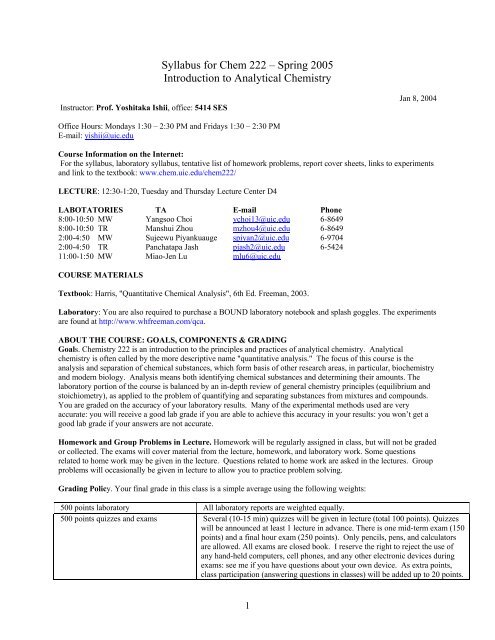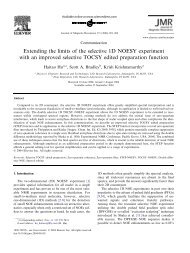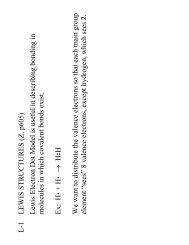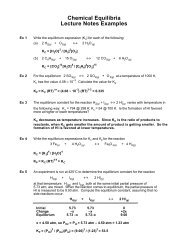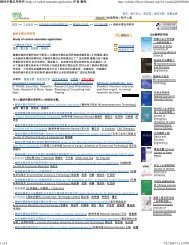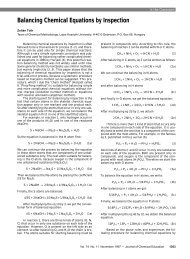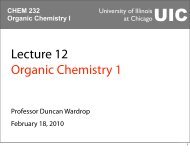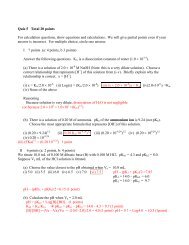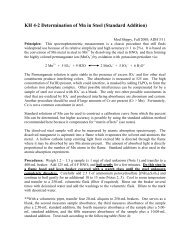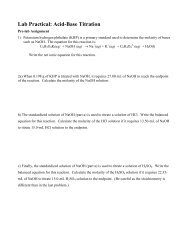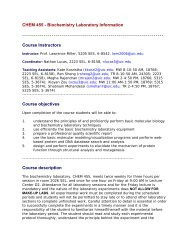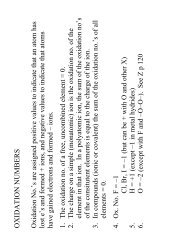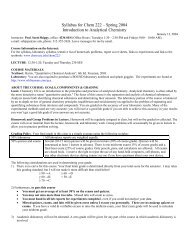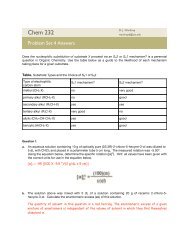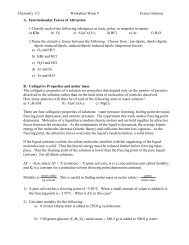Syllabus for Chem 222 - UIC Department of Chemistry
Syllabus for Chem 222 - UIC Department of Chemistry
Syllabus for Chem 222 - UIC Department of Chemistry
You also want an ePaper? Increase the reach of your titles
YUMPU automatically turns print PDFs into web optimized ePapers that Google loves.
<strong>Syllabus</strong> <strong>for</strong> <strong>Chem</strong> <strong>222</strong> – Spring 2005<br />
Introduction to Analytical <strong>Chem</strong>istry<br />
Instructor: Pr<strong>of</strong>. Yoshitaka Ishii, <strong>of</strong>fice: 5414 SES<br />
Jan 8, 2004<br />
Office Hours: Mondays 1:30 – 2:30 PM and Fridays 1:30 – 2:30 PM<br />
E-mail: yishii@uic.edu<br />
Course In<strong>for</strong>mation on the Internet:<br />
For the syllabus, laboratory syllabus, tentative list <strong>of</strong> homework problems, report cover sheets, links to experiments<br />
and link to the textbook: www.chem.uic.edu/chem<strong>222</strong>/<br />
LECTURE: 12:30-1:20, Tuesday and Thursday Lecture Center D4<br />
LABOTATORIES TA E-mail Phone<br />
8:00-10:50 MW Yangsoo Choi ychoi13@uic.edu 6-8649<br />
8:00-10:50 TR Manshui Zhou mzhou4@uic.edu 6-8649<br />
2:00-4:50 MW Sujeewu Piyankuauge spiyan2@uic.edu 6-9704<br />
2:00-4:50 TR Panchatapa Jash pjash2@uic.edu 6-5424<br />
11:00-1:50 MW Miao-Jen Lu mlu6@uic.edu<br />
COURSE MATERIALS<br />
Textbook: Harris, "Quantitative <strong>Chem</strong>ical Analysis", 6th Ed. Freeman, 2003.<br />
Laboratory: You are also required to purchase a BOUND laboratory notebook and splash goggles. The experiments<br />
are found at http://www.whfreeman.com/qca.<br />
ABOUT THE COURSE: GOALS, COMPONENTS & GRADING<br />
Goals. <strong>Chem</strong>istry <strong>222</strong> is an introduction to the principles and practices <strong>of</strong> analytical chemistry. Analytical<br />
chemistry is <strong>of</strong>ten called by the more descriptive name "quantitative analysis." The focus <strong>of</strong> this course is the<br />
analysis and separation <strong>of</strong> chemical substances, which <strong>for</strong>m basis <strong>of</strong> other research areas, in particular, biochemistry<br />
and modern biology. Analysis means both identifying chemical substances and determining their amounts. The<br />
laboratory portion <strong>of</strong> the course is balanced by an in-depth review <strong>of</strong> general chemistry principles (equilibrium and<br />
stoichiometry), as applied to the problem <strong>of</strong> quantifying and separating substances from mixtures and compounds.<br />
You are graded on the accuracy <strong>of</strong> your laboratory results. Many <strong>of</strong> the experimental methods used are very<br />
accurate: you will receive a good lab grade if you are able to achieve this accuracy in your results: you won’t get a<br />
good lab grade if your answers are not accurate.<br />
Homework and Group Problems in Lecture. Homework will be regularly assigned in class, but will not be graded<br />
or collected. The exams will cover material from the lecture, homework, and laboratory work. Some questions<br />
related to home work may be given in the lecture. Questions related to home work are asked in the lectures. Group<br />
problems will occasionally be given in lecture to allow you to practice problem solving.<br />
Grading Policy. Your final grade in this class is a simple average using the following weights:<br />
500 points laboratory All laboratory reports are weighted equally.<br />
500 points quizzes and exams Several (10-15 min) quizzes will be given in lecture (total 100 points). Quizzes<br />
will be announced at least 1 lecture in advance. There is one mid-term exam (150<br />
points) and a final hour exam (250 points). Only pencils, pens, and calculators<br />
are allowed. All exams are closed book. I reserve the right to reject the use <strong>of</strong><br />
any hand-held computers, cell phones, and any other electronic devices during<br />
exams: see me if you have questions about your own device. As extra points,<br />
class participation (answering questions in classes) will be added up to 20 points.<br />
1
The following considerations are used in determining your grade:<br />
1) Your final letter grade is determined directly from your total score <strong>for</strong> the semester. This grading standard may<br />
be relaxed a little, but I will not make it more difficult than cited below. A linear curve may be applied in order<br />
to give A to ~ 15 % <strong>of</strong> students.<br />
> 90 % →A > 80 % →B > 65 % →C > 50 %→D < 50 % →E<br />
2) Furthermore, to pass this course<br />
• You must get an average <strong>of</strong> at least 50% on the exams and quizzes.<br />
• You may not miss more than two labs or classes (in total).<br />
• You must hand in all lab reports <strong>for</strong> experiments completed, even if you could not analyze your data.<br />
• Missed quizzes, exams, and labs will be given zeros unless I excuse you personally. There are no makeup<br />
quizzes or exams.<br />
3) Please don’t miss any classes or labs. Please do not be late. There is some penalty.<br />
• In case you have to miss any lab, you need to in<strong>for</strong>m me and your Lab Teaching Assistant (TA) at least one<br />
day (24 hours) in advance and obtain permission from me. Otherwise, missed labs will count as zeros.<br />
• If you are late <strong>for</strong> more than 10 minutes, we will subtract 5 % (up to 30 mins), 20 % (up to 1 hour), or<br />
50 % (more than an hour) <strong>of</strong> your Lab grade <strong>for</strong> the corresponding report. The penalty can be<br />
accumulated if you are late more than twice <strong>for</strong> the same report.<br />
• In case you have to miss any lecture, you need to in<strong>for</strong>m me at least one day in advance and obtain<br />
permission. Otherwise, a missed lecture will lead to 5 point reduction (5%) in your final grade.<br />
• If you are late <strong>for</strong> more than 5 or 10 minutes <strong>for</strong> a lecture, I reserve a right to subtract 0.5 % or 2 % in<br />
your final grade, respectively.<br />
• All the above penalties accumulate. For example, if you miss one lecture and you are 30 minutes late in one<br />
lecture, your penalty is 5% + 2% = 7 %.<br />
• If you have a valid & verifiable excuse (ex. medical emergency or death <strong>of</strong> your direct family member) to miss<br />
the midterm exam, your final exam grade will be used to calculate your midterm grade.<br />
• Academic dishonesty will not be tolerated. Grade E will be given <strong>for</strong> the overall course grade if you are<br />
involved in academic dishonesty.<br />
• If we find that you are disturbing the class (lab or lecture) or per<strong>for</strong>ming dangerous practice in lab, your<br />
Lab TA or I will request you to leave the class. In this case, you are considered to be absent without notice.<br />
Namely, no points will be given <strong>for</strong> the lab or 5 % reduction will be incurred <strong>for</strong> the lecture.<br />
4) Incomplete grades are only given if you have a valid and verifiable medical excuse to miss the final exam. If you<br />
have a
LABORATORY NOTES<br />
The Lab Notebook. Scientists keep careful records <strong>of</strong> their experiments, including observations, data, and<br />
comments on what worked and what didn't work. For this course, you must purchase and use a bound laboratory<br />
notebook (i.e., a composition book) and organize it in such a way that anyone could easily follow your progress<br />
through the assigned experiments. Your lab notebook must be recorded in blue or black ink and should contain:<br />
1. A Table <strong>of</strong> Contents.<br />
2. Numbered pages.<br />
3. No torn out pages. Instead, neatly cross out any unwanted pages.<br />
4. Corrections to items in your notebook must be made by drawing a single horizontal line through the items<br />
to be corrected.<br />
5. Write on and number only the right facing page, keeping the back facing page blank <strong>for</strong> scratch work.<br />
6. Use correct English grammar and spelling throughout.<br />
7. Final analysis <strong>of</strong> your data and your final results, clearly written in blue or black ink.<br />
8. You must prepare your lab notebook be<strong>for</strong>e you start each experiment as follows:<br />
a. Describe the experiment to be per<strong>for</strong>med. You can write this description in your own words and/or use a<br />
photocopy <strong>of</strong> the description <strong>of</strong> the experiment. In addition, a flow chart <strong>for</strong> the experiment is required.<br />
b. Outline the calculations you will use to convert the experimental data to the answers required on the lab<br />
cover sheet (see www.chem.uic/chem<strong>222</strong>). Preparing tables <strong>for</strong> all the data you expect to collect that<br />
day in the lab is the best practice.<br />
c. Your notebook will be checked by your TA be<strong>for</strong>e you start your experiment. If your notebook is not<br />
properly prepared, you may not start your experiment.<br />
9. All plots, computer-generated material and Photocopies should be neatly glued, taped, or stapled into the<br />
notebook. All fitting <strong>of</strong> data to straight lines must be done by linear least squares analysis. Numerical<br />
values <strong>for</strong> the slope and intercept must be given and errors in the slope and intercept as well as the<br />
correlation coefficient must be included.<br />
10. Your final lab grade will include a grade <strong>for</strong> your lab notebook as well as <strong>for</strong> lab etiquette. Etiquette<br />
includes arriving on time <strong>for</strong> the lab session, proper use <strong>of</strong> the balance as well as other lab equipment, the<br />
development <strong>of</strong> good lab techniques, and finally leaving the lab space clean and ordered.<br />
Your TA must sign your data pages on the day the data is recorded.<br />
Lab Report Procedure. Do not hand in your lab notebook to the TA until the end <strong>of</strong> the term. Lab reports will<br />
have the following in<strong>for</strong>mation in them:<br />
1. Cover sheet with the final results and a statement <strong>of</strong> what you measured (i.e., Nicotine in unknown tobacco<br />
sample #_____) unknown number, average value <strong>of</strong> your determinations, and both absolute and relative<br />
standard deviations. YOU NEED TO PRINT OUT A COVER SHEET TO RECORD YOUR LAB RESULTS<br />
at the web site (www.chem.uic.edu/chem<strong>222</strong>).<br />
2. Analysis section (2-4 pages in double space). Summarize your analysis <strong>for</strong> the lab. Clearly explain how you<br />
calculated the results you filled in the cover sheet. Show at least example calculations. Also, show graphs etc if<br />
they are required <strong>for</strong> analysis. Type this section <strong>for</strong> clarity.<br />
3. Photocopy <strong>of</strong> the experiment description you placed in your notebook be<strong>for</strong>e the start <strong>of</strong> the experiment.<br />
4. Photocopy (or carbon) copies <strong>of</strong> the signed data pages you recorded in lab. Do not recopy these <strong>for</strong> neatness.<br />
Lab Report Due Dates. See the "Lab Schedule and Lab Due Dates" sheet or the Internet <strong>for</strong> actual due dates.<br />
Revisions to the schedule will only be posted on the Internet. Hand in reports to your own TA during the lab<br />
session. If you cannot complete a lab, but have collected some data on it, then your TA should make a note to this<br />
effect on your lab report and you will receive some credit <strong>for</strong> your ef<strong>for</strong>t (~30%). Please note that your lab notebook<br />
must contain data <strong>for</strong> all assigned experiments.<br />
3


